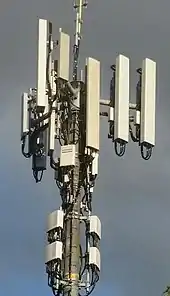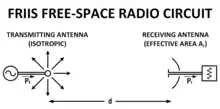Friis transmission equation
The Friis transmission formula is used in telecommunications engineering, equating the power at the terminals of a receive antenna as the product of power density of the incident wave and the effective aperture of the receiving antenna under idealized conditions given another antenna some distance away transmitting a known amount of power.[1] The formula was presented first by Danish-American radio engineer Harald T. Friis in 1946.[2] The formula is sometimes referenced as the Friis transmission equation.
| Part of a series on |
| Antennas |
|---|
 |
Friis' original formula
Friis' original idea behind his transmission formula was to dispense with the usage of directivity or gain when describing antenna performance. In their place is the descriptor of antenna capture area as one of two important parts of the transmission formula that characterizes the behavior of a free-space radio circuit.[2]

This leads to his published form of his transmission formula...
where:
- is the power fed into the transmitting antenna input terminals;[2]
- is the power available at receiving antenna output terminals;[2]
- is the effective aperture area of the receiving antenna;[2]
- is the effective aperture area of the transmitting antenna;[2]
- is the distance between antennas;[2]
- is the wavelength of the radio frequency;[2]
- and are in the same units of power;[2]
- , , , and are in the same units.[2]
- Distance large enough to ensure a plane wave front at the receive antenna sufficiently approximated by where is the largest linear dimension of either of the antennas.[2]
Friis stated the advantage of this formula over other formulations is the lack of numerical coefficients to remember, but does require the expression of transmitting antenna performance in terms of power flow per unit area instead of field strength and the expression of receiving antenna performance by its effective area rather than by its power gain or radiation resistance.[2]
Contemporary formula
Few follow Friis' advice on using antenna effective area to characterize antenna performance over the contemporary use of directivity and gain metrics. Replacing the effective antenna areas with their directivity counterparts yields
where and are the antenna directivities (with respect to an isotropic radiator) of the transmitting and receiving antennas respectively, is the wavelength representing the effective aperture area of the receiving antenna, and is the distance between the antennas.[1] To use the equation as written, the antenna directivities are linear values, and the wavelength and distance units must be the same. To calculate using decibels (dB), the equation is modified to:
The simple form applies under the following conditions:
- such that both antennas are in the far field of each other.[1]
- is the power delivered to the terminals of an isotropic transmit antenna.[3]
- is the available power at the receive antenna terminals equal to the product of the power density of the incident wave and the effective aperture area of the receiving antenna proportional to .[1]
- is the isotropic directivity of the transmitting antenna in the direction of the receiving antenna.[1]
- is the isotropic directivity of the receiving antenna in the direction of the transmitting antenna.[1]
- The antennas are correctly aligned and have the same polarization.[4]
- The antennas are in unobstructed free space, with no multipath.[4]
- The bandwidth is narrow enough that a single value for the wavelength can be assumed.[4]
The ideal conditions are almost never achieved in ordinary terrestrial communications, due to obstructions, reflections from buildings, and most importantly reflections from the ground. One situation where the equation is reasonably accurate is in satellite communications when there is negligible atmospheric absorption; another situation is in anechoic chambers specifically designed to minimize reflections.[5]
Derivation
There are several methods to derive the Friis transmission equation. In addition to the usual derivation from antenna theory, the basic equation also can be derived from principles of radiometry and scalar diffraction in a manner that emphasizes physical understanding.[6] Another derivation is to take the far-field limit of the near-field transmission integral, as described in e.g.[7]
See also
Sources of further information
- Harald T. Friis, "A Note on a Simple Transmission Formula," Proceedings of the I.R.E. and Waves and Electrons, May, 1946, pp 254–256.
- J.D.Kraus, "Antennas," 2nd Ed., McGraw-Hill, 1988.
- Kraus and Fleisch, "Electromagnetics," 5th Ed., McGraw-Hill, 1999.
- D.M.Pozar, "Microwave Engineering." 2nd Ed., Wiley, 1998.
- Shaw, J.A. (2013). "Radiometry and the Friis transmission equation". Am. J. Phys. 81 (33): 33–37. doi:10.1119/1.4755780.
References
- Johnson, Richard (1984). Antenna Engineering Handbook (2nd ed.). New York, NY: McGraw-Hill, Inc. p. 1-12. ISBN 0-07-032291-0.
- Friis, H.T. (May 1946). "A Note on a Simple Transmission Formula". IRE Proc. 34 (5): 254–256. doi:10.1109/JRPROC.1946.234568. S2CID 51630329.
- Stutzman, Warren; Thiele, Gary (1981). Antenna Theory and Design. John Wiley & Sons, Inc. p. 60. ISBN 0-471-04458-X.
- Bevelacqua, Pete. "Friis Equation - (aka Friis Transmission Formula)". www.antenna-theory.com. Retrieved 2018-08-21.
- Jayakody, Dushantha Nalin K.; Thompson, John; Chatzinotas, Symeon; Durrani, Salman (2017-07-20). Wireless Information and Power Transfer: A New Paradigm for Green Communications. Springer. p. 193. ISBN 9783319566696.
- Shaw, Joseph A. (2013). "Radiometry and the Friis transmission equation". American Journal of Physics. 81: 33–37. doi:10.1119/1.4755780.
- Frid, H.; Holter, H.; Jonsson, B. L. G. (2015). "An Approximate Method for Calculating the Near-Field Mutual Coupling Between Line-of-Sight Antennas on Vehicles". IEEE Transactions on Antennas and Propagation. 63 (9): 4132–4138. doi:10.1109/TAP.2015.2447003. S2CID 13059054.